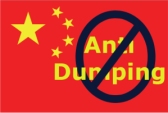 If you have an interest in the U.S. antidumping laws, LawCustoms recommends Antidumping Duties: Separate Rate – Staying Ahead of The Trading Curve. The article is based on the analysis and application of the U.S. antidumping laws from the perspective of the U.S. importer and non-U.S. exporter who seek to qualify for the separate antidumping rate. The author suggests a lower cost alternative called “separate rate” available to the manufacturers and exporters of “non-market economy” nations such as the People’s Republic of China. Antidumping Duties: Separate Rate explores a recent record record published by the International Trade Administration, U.S. Customs, as well as, other governmental bodies and synthesized it into a story of experiences by members of international trade community. While the focus of the article is the application of the U.S. antidumping regime to the People’s Republic of China, many of the principles can be extended to other countries also.
If you have an interest in the U.S. antidumping laws, LawCustoms recommends Antidumping Duties: Separate Rate – Staying Ahead of The Trading Curve. The article is based on the analysis and application of the U.S. antidumping laws from the perspective of the U.S. importer and non-U.S. exporter who seek to qualify for the separate antidumping rate. The author suggests a lower cost alternative called “separate rate” available to the manufacturers and exporters of “non-market economy” nations such as the People’s Republic of China. Antidumping Duties: Separate Rate explores a recent record record published by the International Trade Administration, U.S. Customs, as well as, other governmental bodies and synthesized it into a story of experiences by members of international trade community. While the focus of the article is the application of the U.S. antidumping regime to the People’s Republic of China, many of the principles can be extended to other countries also.
The story begins with a general overview and evolution of the U.S. antidumping laws from the Wilson Act to the present day Tariff Act. The overview touches on roles and responsibilities played by the manufacturers, exporters, importers, and governmental agencies. Then, the article suggests a practical “checklist” of key elements that may be useful to the current and prospective exporters/importers of the products subject to the U.S. antidumping duties. List of suggested considerations includes: the period of review; concept of affiliated party transaction; governmental control and ownership; proprietary information. The author touches on administrative costs and privacy concern, as well as, worst case scenario of getting involved. The article describes the effect of antidumping laws on the relationships and behavior on the trading parties. Antidumping Duties ends with a set of recommendations that call for a greater government tranparency and involvement into the process by professionals on both sides of the ocean.
The article’s introduction is reproduced below:
Antidumping policies have attracted a lot of attention in domestic and international trade circles because of their strong ability to influence trade flows and manufacturing geography. The antidumping practice dominates World Trade Organization (WTO) agenda and regarded as one of the prevalent barriers to international trade. Antidumping tariffs have the effect of canceling out regular tariffs, which have otherwise been on decline as a result of bilateral trade negotiations between nations and multilateral forums such as General Agreement on Tariffs and Trade and its successor body – WTO. More frequent antidumping duty investigations require businesses to be more aware about how antidumping may affect their logistical and production business structure. One group of businesses that feels a higher impact than others is exporters of “dumped” product. This paper explores legal and administrative requirements for these businesses in a sub-area of the United States antidumping regime – the separate rate, specifically focusing on voluntary participants. While the separate rate voluntary participation applies to any antidumping investigation, the focus here is on the China – United States trade. The paper concludes that voluntary participants can achieve a separate rate status, but numerous obstacles make separate rate endeavor costly. Reliance on the internet as a mode of communication and dissemination of information can lessen the impact of various obstacles faced by voluntary participants in separate rate antidumping duty investigations. Voluntary participants, however, face a collective U.S. industrial lobby with a long history of associationalism. This paper addresses these obstacles individually and attempts to assist Chinese exporters, which sell products subject to the U.S. antidumping duties, make an informed decision as to whether get involved in a voluntary separate rate process and qualify for the separate antidumping duty rate.
To continue reading please click here.
[slideshow]
